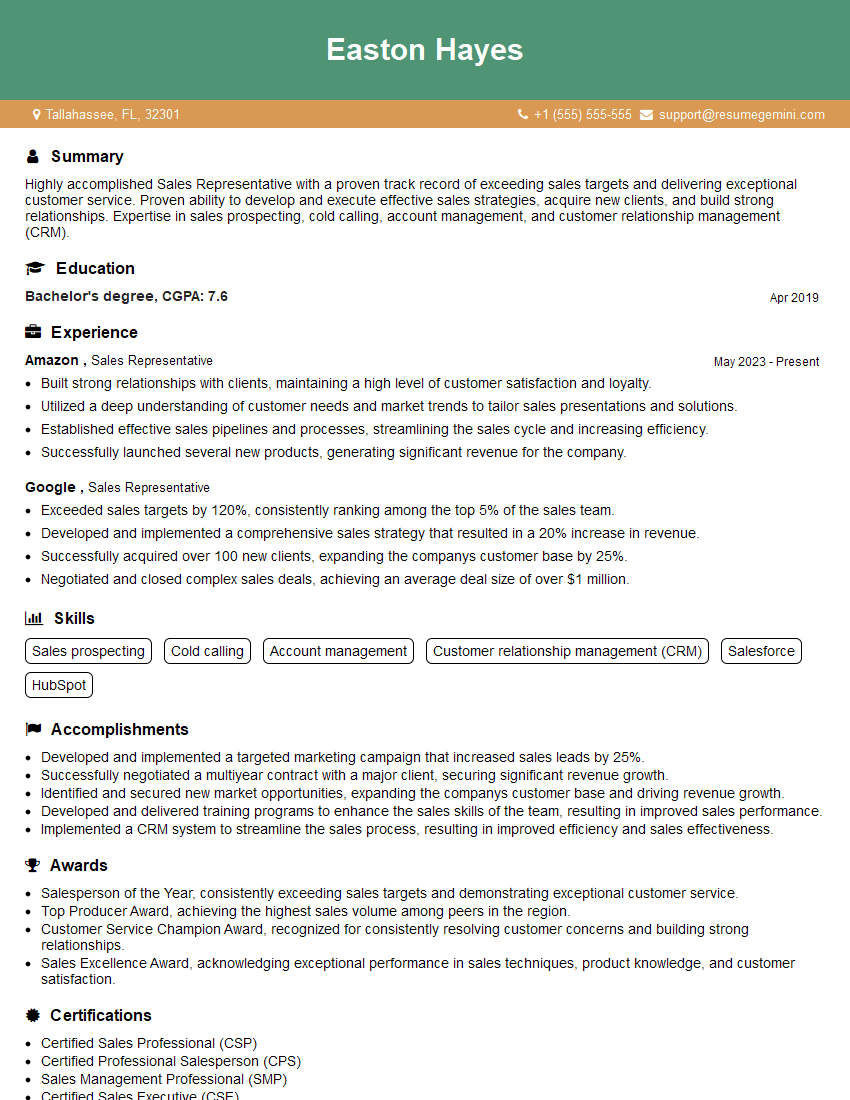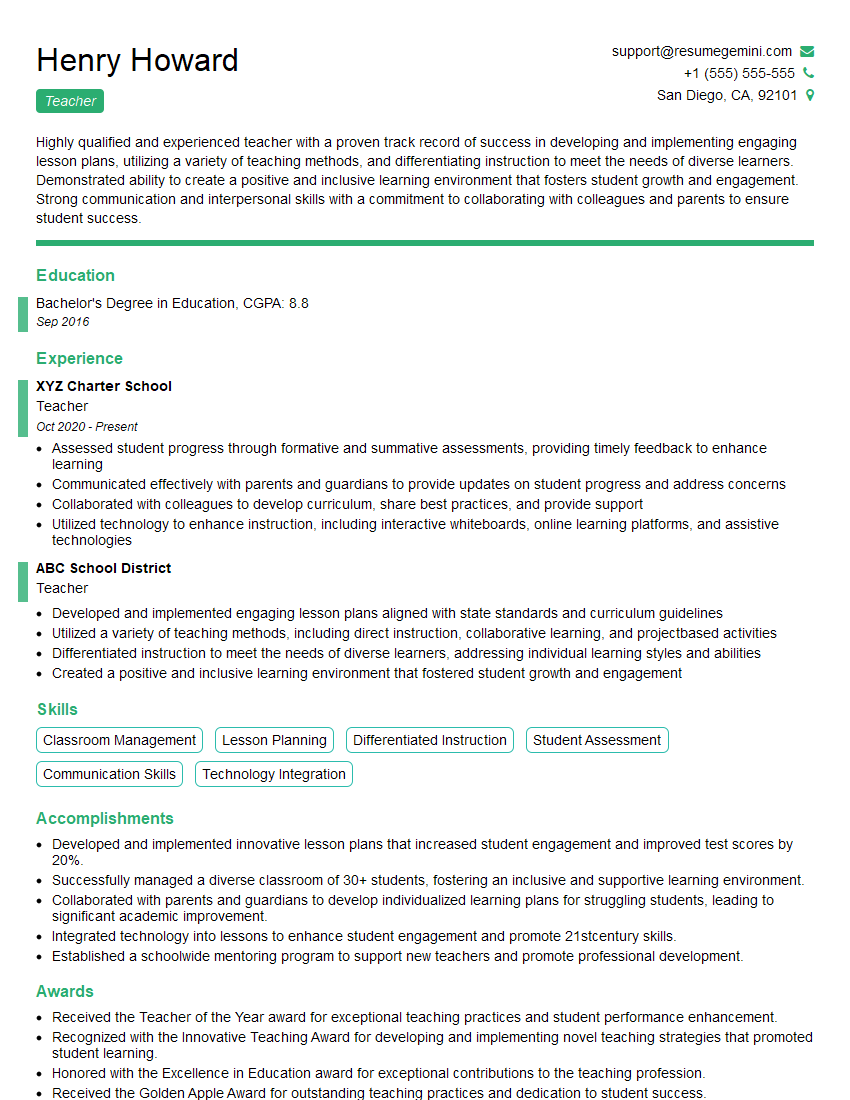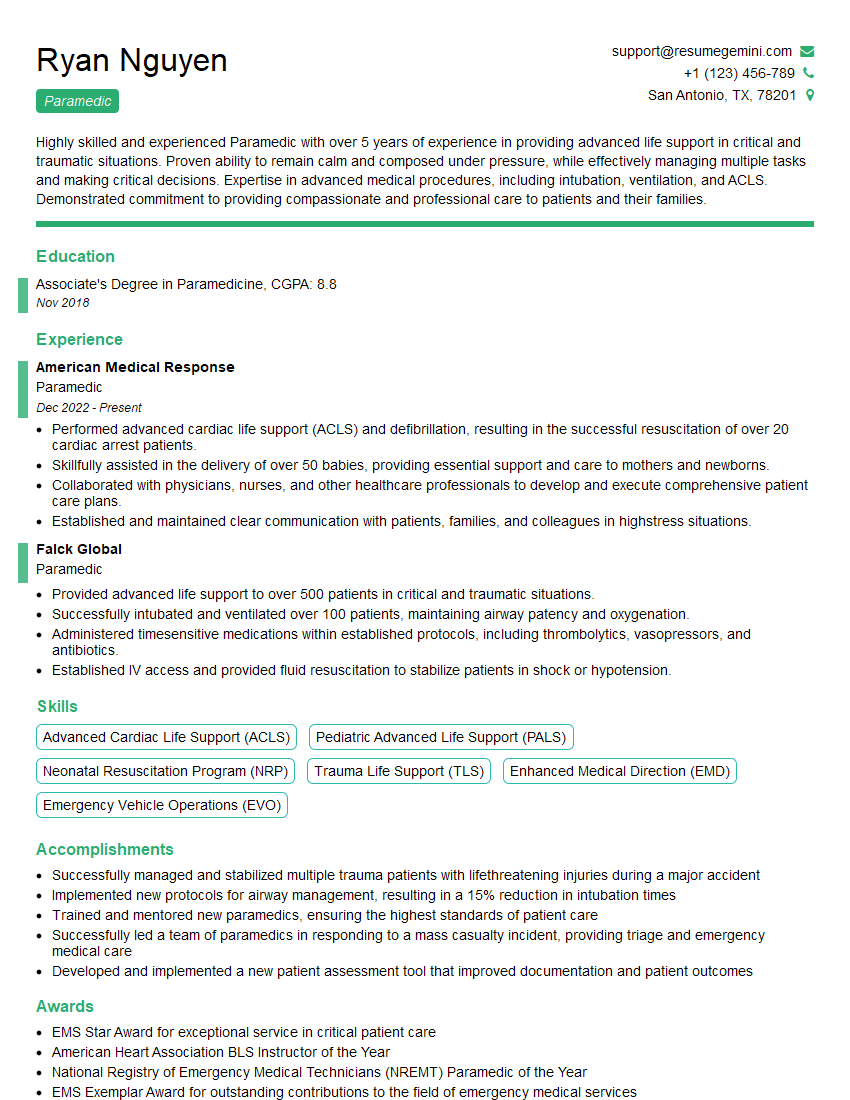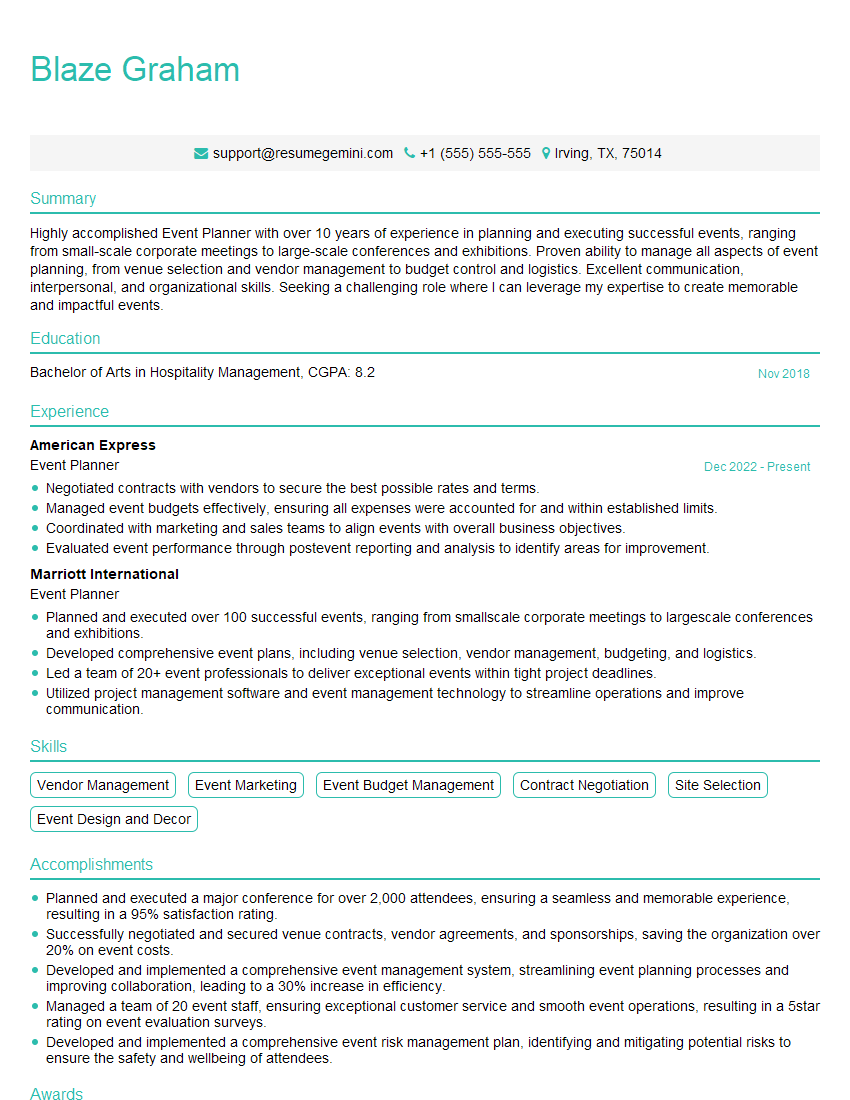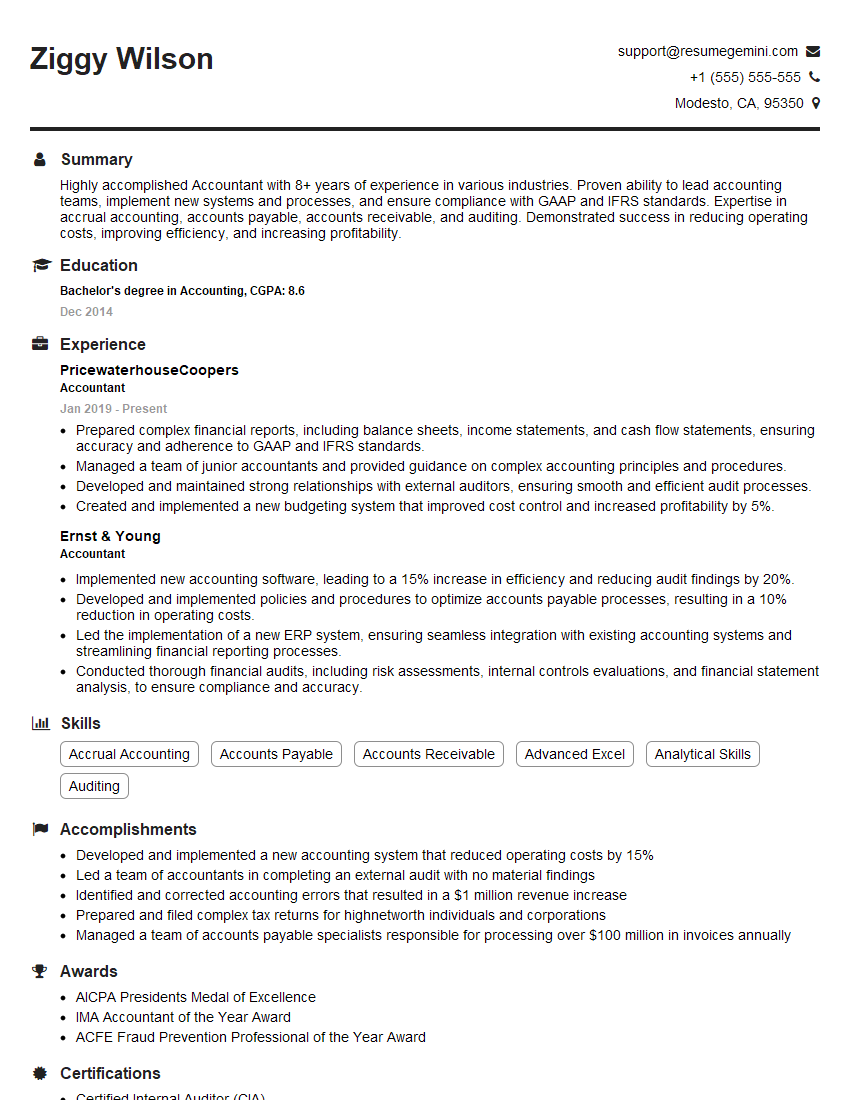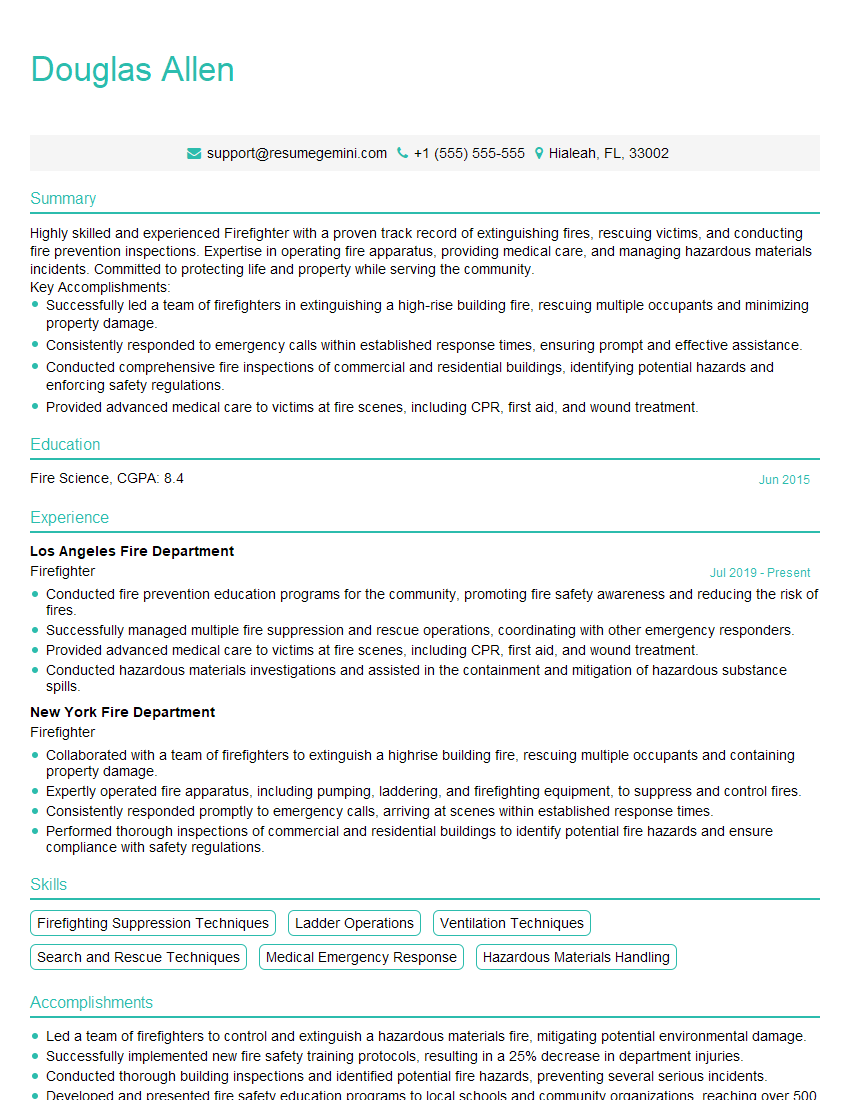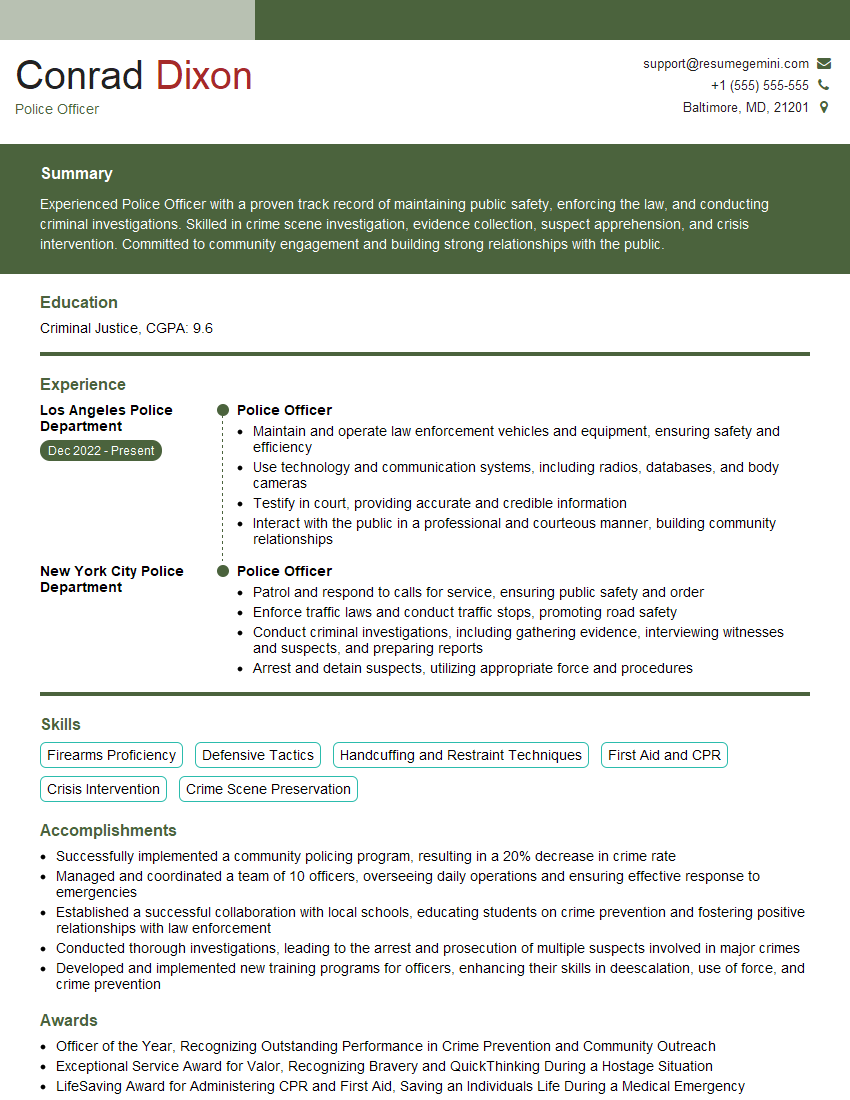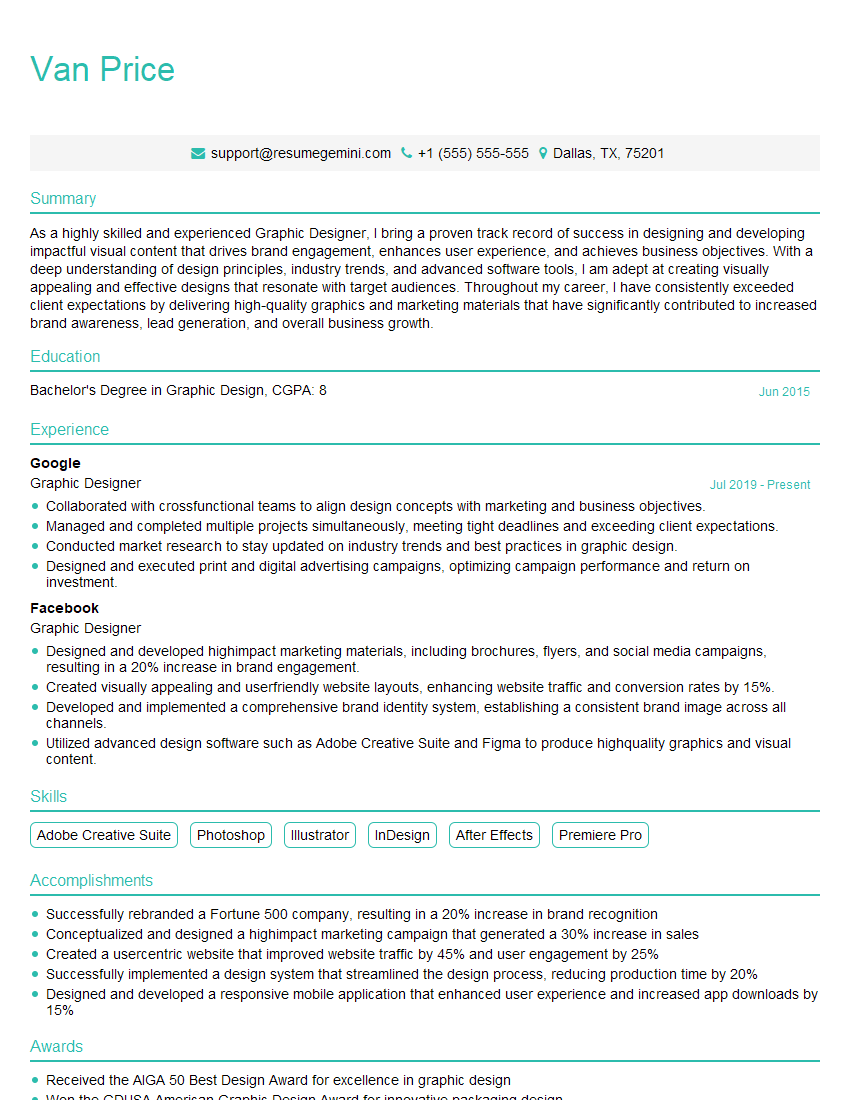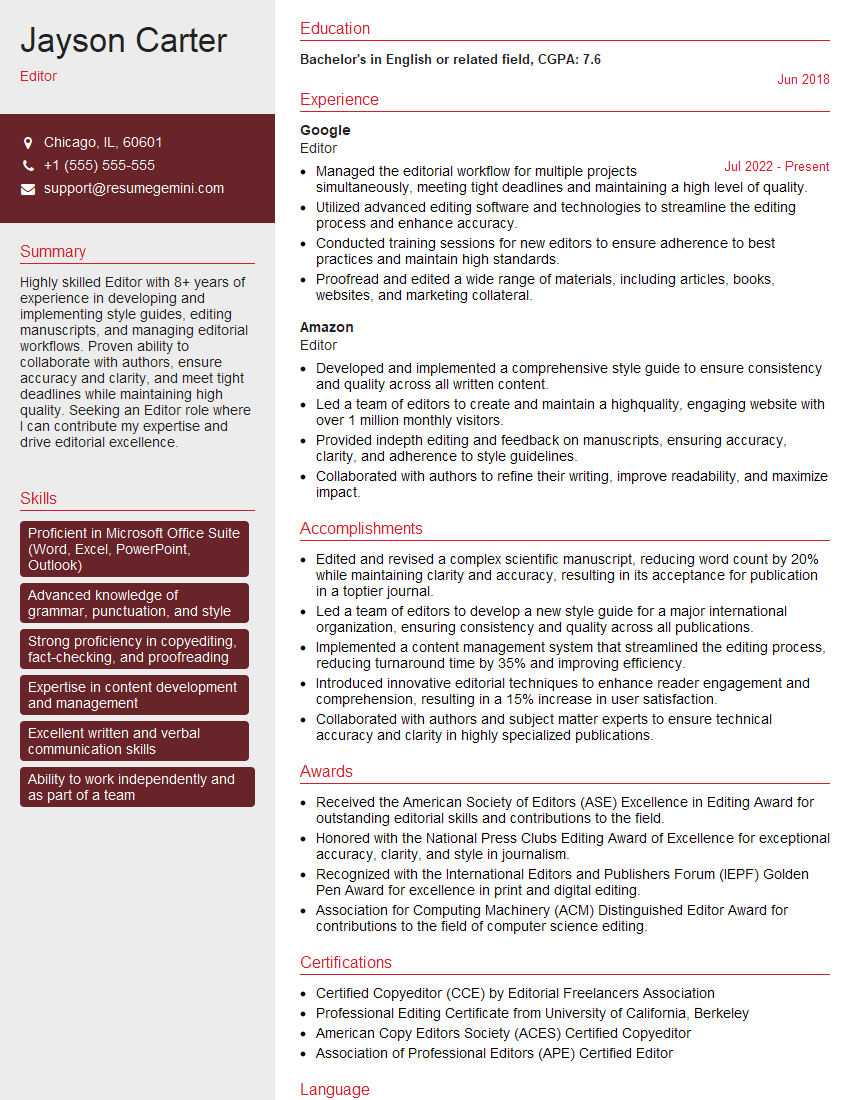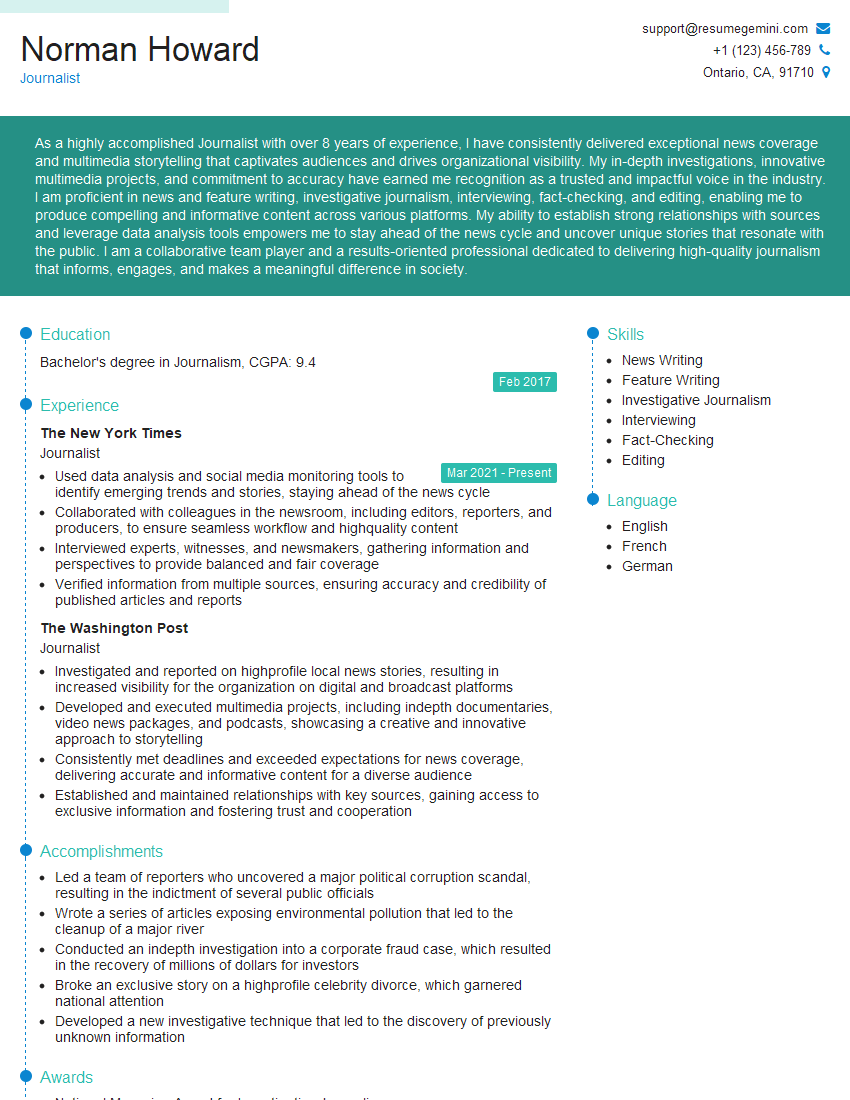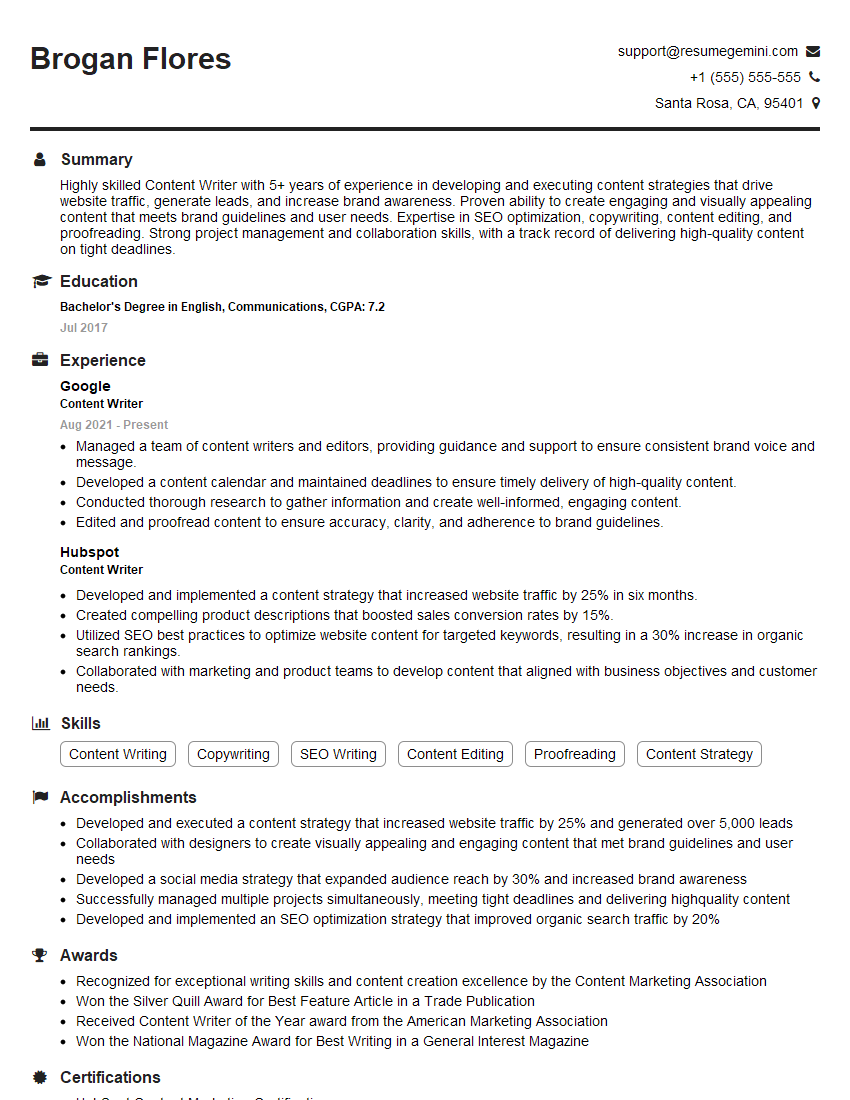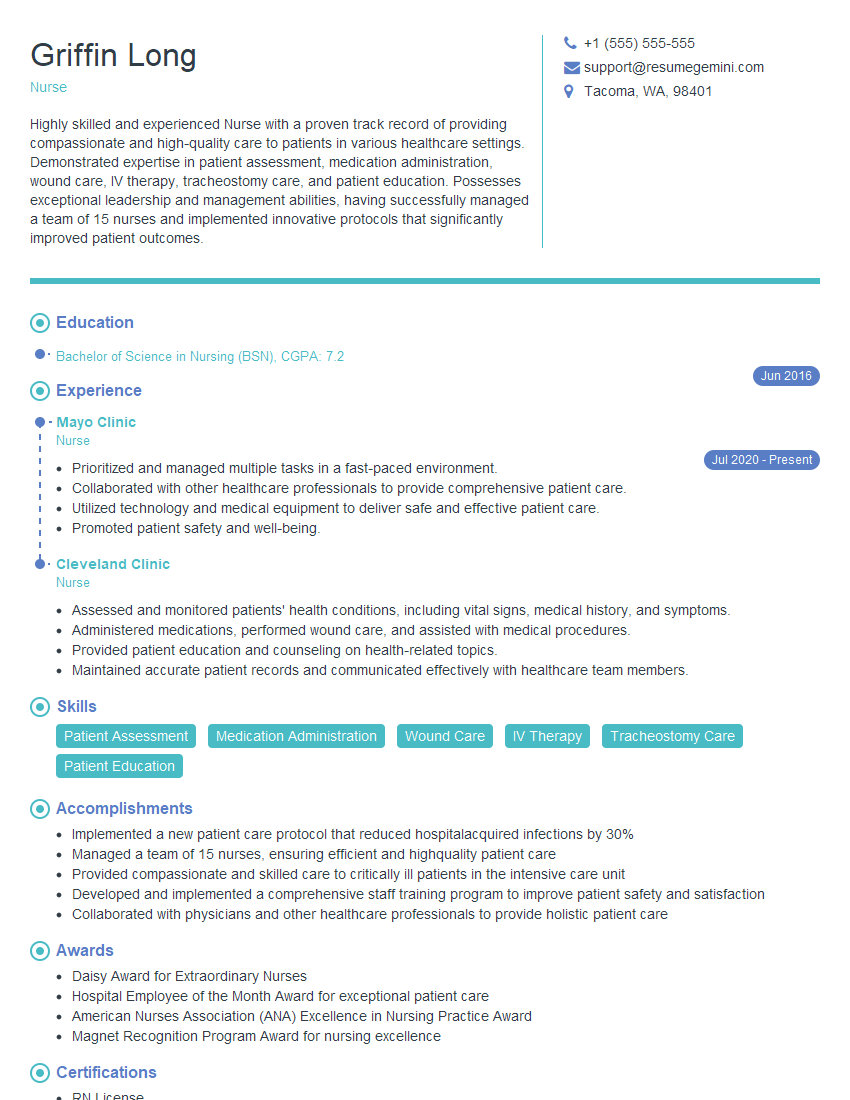Interviews are opportunities to demonstrate your expertise, and this guide is here to help you shine. Explore the essential Ability to work under tight deadlines interview questions that employers frequently ask, paired with strategies for crafting responses that set you apart from the competition.
Questions Asked in Ability to work under tight deadlines Interview
Q 1. Describe a situation where you had to meet a very tight deadline. What strategies did you employ?
During my time at Acme Corp, we were tasked with launching a new software product within an incredibly tight, three-month timeframe. This involved coordinating with multiple teams across different time zones and integrating several complex functionalities. To meet this aggressive deadline, I employed several key strategies:
- Detailed Project Breakdown: We meticulously broke down the project into smaller, manageable tasks, assigning clear owners and deadlines for each. This allowed us to track progress effectively and identify potential bottlenecks early on.
- Prioritization Matrix: We utilized a prioritization matrix to focus on the most critical tasks first. This involved assigning weights based on urgency and impact, ensuring that the most impactful features were completed even if it meant sacrificing less important ones.
- Daily Stand-up Meetings: Short, daily stand-up meetings were crucial for keeping everyone aligned and addressing any roadblocks immediately. This fostered a culture of open communication and quick problem-solving.
- Agile Methodology: Adopting an Agile methodology, with short sprints and iterative development, enabled us to adapt quickly to changing requirements and incorporate feedback efficiently.
- Overtime (Judiciously): While we aimed for efficiency, we also acknowledged that some overtime might be necessary. We ensured it was distributed fairly and strategically, focusing on critical tasks and avoiding burnout.
This multi-pronged approach allowed us to successfully launch the product on time and to a high standard, exceeding initial expectations despite the tight deadline.
Q 2. How do you prioritize tasks when faced with multiple deadlines?
Prioritizing tasks with multiple deadlines requires a structured approach. I typically use a combination of methods:
- Eisenhower Matrix (Urgent/Important): This classic matrix helps categorize tasks based on urgency and importance. Urgent and important tasks get immediate attention, while less urgent tasks are scheduled accordingly.
- Dependency Mapping: I create a visual representation of task dependencies to identify which tasks need to be completed before others can begin. This prevents bottlenecks and ensures efficient workflow.
- Time Blocking: Allocating specific time blocks for each task allows for focused work and minimizes distractions. I build in buffer time to account for unexpected delays.
- Regular Review and Adjustment: Deadlines are dynamic. Regularly reviewing my task list and adjusting priorities based on new information or changing circumstances is critical.
For example, if I have a high-priority presentation due tomorrow and a lower-priority report due next week, I’d focus my immediate efforts on the presentation, ensuring it’s polished and ready before tackling the report.
Q 3. What’s your approach to managing stress when working under pressure?
Managing stress under pressure is crucial for productivity and well-being. My approach involves several key strategies:
- Time Management: Effective time management minimizes last-minute rushes and reduces stress. Breaking down large tasks, prioritizing effectively, and utilizing time-blocking techniques are instrumental.
- Mindfulness and Breaks: Taking short breaks throughout the day helps maintain focus and prevents burnout. Mindfulness techniques, such as deep breathing exercises, can calm the mind and reduce stress.
- Healthy Lifestyle: Maintaining a healthy diet, regular exercise, and sufficient sleep are foundational for stress management. A healthy body contributes to a healthy mind.
- Delegation: When appropriate, I delegate tasks to others to share the workload and avoid feeling overwhelmed. Trusting my team is key.
- Open Communication: Talking to my manager or colleagues about my workload and challenges can help alleviate stress and identify potential support.
Think of it like a marathon, not a sprint. Sustained effort with mindful breaks is key to reaching the finish line without exhaustion.
Q 4. Have you ever missed a deadline? If so, what happened and what did you learn?
Yes, I once missed a deadline on a smaller project due to an unexpected technical issue that required more troubleshooting time than initially anticipated. I underestimated the complexity of integrating a third-party API.
What happened: I failed to proactively communicate the delay to stakeholders early enough. This led to some frustration and impacted the overall project timeline.
What I learned: The importance of:
- Realistic Time Estimation: More accurate initial estimations of tasks, including buffer time for unexpected issues.
- Proactive Communication: Keeping stakeholders informed of any delays, even minor ones, is critical for managing expectations and avoiding misunderstandings.
- Risk Assessment: Identifying potential risks and developing contingency plans to mitigate them upfront.
This experience significantly improved my project planning and communication skills. Now, I’m much more proactive in anticipating potential problems and communicating effectively.
Q 5. How do you handle unexpected changes or delays that impact project deadlines?
Unexpected changes or delays are inevitable in project management. My approach involves:
- Re-evaluation and Reprioritization: I immediately re-evaluate the project plan, taking the new information into account. This might involve adjusting priorities, shifting resources, or extending deadlines.
- Communication: Transparent communication with the team and stakeholders is key. I explain the change, its impact, and the plan to address it.
- Problem-Solving: I work collaboratively with the team to find creative solutions to overcome the obstacle. This often involves brainstorming and exploring alternative approaches.
- Documentation: I update the project documentation to reflect the changes and maintain a clear record of decisions and actions taken.
For example, if a key supplier delays a component, I’d immediately communicate with the team, explore alternative suppliers, re-prioritize tasks, and adjust the project schedule accordingly.
Q 6. Describe your experience using project management tools to track deadlines and progress.
I have extensive experience using various project management tools, including Jira, Asana, and Trello. These tools are invaluable for tracking deadlines, managing tasks, and monitoring progress.
My approach involves:
- Task Creation and Assignment: I use these tools to create detailed tasks, assign them to team members, and set clear deadlines.
- Progress Tracking: I regularly monitor progress using dashboards and reports provided by the tools. This allows me to identify any potential delays or bottlenecks early on.
- Collaboration: These tools facilitate communication and collaboration within the team, allowing for efficient sharing of information and updates.
- Reporting: I use the tools to generate reports on project status for stakeholders, providing transparency and accountability.
For instance, in Jira, I’d create user stories, assign them to developers, track their progress through different statuses (e.g., To Do, In Progress, Testing, Done), and use the Kanban board to visualize the workflow.
Q 7. How do you communicate effectively with your team when working against tight deadlines?
Effective communication is paramount when working under tight deadlines. My approach focuses on:
- Clear and Concise Updates: I provide regular, concise updates to the team, focusing on key information and avoiding unnecessary details. This is particularly important in daily stand-up meetings.
- Open Communication Channels: I encourage open communication through various channels (e.g., instant messaging, email, project management tools) to facilitate quick responses and problem-solving.
- Active Listening: I actively listen to team members’ concerns and suggestions, creating a safe space for feedback and collaboration.
- Transparency: I ensure transparency regarding project status, challenges, and changes to keep the team informed and motivated.
- Conflict Resolution: I address any conflicts or disagreements promptly and fairly, finding solutions that meet the needs of the project and the team.
For example, if a task is falling behind schedule, I’d immediately communicate this to the team, identify the reasons for the delay, and collaboratively work towards a solution, perhaps reassigning tasks or adjusting priorities.
Q 8. How do you delegate tasks effectively when working under pressure?
Effective delegation under pressure isn’t about dumping tasks; it’s about strategically assigning responsibilities to the right people. I prioritize clarity and communication. First, I clearly define the task, its scope, and the desired outcome. Then, I assess my team members’ strengths and skillsets to match the task to the individual best equipped to handle it. This includes considering their workload and current capacity. Finally, I provide sufficient guidance, set realistic expectations, and establish clear communication channels for updates and support. Think of it like assembling a sports team – you wouldn’t put your best point guard in goal, right?
For instance, in a past project with a looming deadline, I had a complex data analysis task. Rather than doing it myself, I delegated the data cleaning to a team member proficient in that area, the analysis to another with strong statistical skills, and the report writing to a third with excellent communication abilities. This division of labor, coupled with regular check-ins, allowed us to deliver a high-quality report on time.
Q 9. Can you provide an example of a time you successfully met a seemingly impossible deadline?
During a major software release, we faced an unexpected critical bug just three days before the launch deadline. The issue seemed insurmountable, given the complexity of our codebase. My team and I immediately implemented a crisis management plan. We prioritized the bug fix, dividing the problem into smaller, manageable tasks, assigning each to a specialist, and working around the clock. We utilized agile methodologies, conducting frequent code reviews and deploying quick fixes after rigorous testing. Transparency and open communication were key; everyone understood the urgency and the contributions of each individual. Ultimately, we successfully resolved the bug, thoroughly tested the fix, and launched on schedule. The experience highlighted the power of collaborative problem-solving and rapid iteration under extreme pressure.
Q 10. How do you balance quality of work with the need to meet deadlines?
Balancing quality and speed requires a strategic approach. It’s not a compromise, but rather a careful prioritization. I start by clearly defining the minimum viable product (MVP) – the core features absolutely necessary to meet the deadline. Then, I focus my team’s efforts on delivering high-quality work within the MVP scope. Any non-essential features can be deferred for a later release. Throughout the process, we emphasize rigorous testing and quality assurance to catch errors early. It’s like baking a cake – you need to focus on the fundamental ingredients and baking process first to get a successful cake, rather than worrying about the icing until later.
Q 11. What are your preferred methods for time management?
My time management hinges on a combination of techniques. I use a project management software (like Asana or Jira) to track tasks, deadlines, and dependencies. I prioritize tasks using methods like the Eisenhower Matrix (urgent/important), breaking down large tasks into smaller, manageable chunks. I schedule time blocks for focused work, minimizing distractions. Regular time audits help me understand where my time is actually going, allowing for adjustments. Lastly, I build buffer time into my schedule to account for unexpected delays and to prevent burnout.
Q 12. How do you identify potential roadblocks before they impact deadlines?
Proactive risk identification involves thorough planning and constant monitoring. Before starting a project, I conduct a thorough risk assessment, identifying potential roadblocks such as resource constraints, technical challenges, or dependency issues. During project execution, I maintain regular communication with my team, actively seeking updates and potential problems. I use visual tools like Gantt charts to track progress and identify any deviations from the schedule. Early detection allows for proactive mitigation strategies. For example, if a dependency is delayed, I can adjust the schedule or explore alternative solutions before it impacts the overall deadline.
Q 13. How do you proactively avoid falling behind schedule?
Avoiding falling behind requires proactive measures from the start. This includes accurate estimation of task durations, realistic scheduling, and building buffer time into the plan. I prioritize tasks rigorously and monitor progress regularly, adjusting the schedule as needed. Open communication with the team and stakeholders is essential; identifying and addressing potential problems early is crucial. I also employ time-blocking techniques to dedicate focused time to critical tasks and prevent context switching. Finally, I don’t shy away from seeking help when needed. Asking for assistance or clarification is a strength, not a weakness, especially when working under tight deadlines.
Q 14. What techniques do you use to stay organized when working on multiple projects with tight deadlines?
Managing multiple projects with tight deadlines demands meticulous organization. I use a robust project management system to track all my projects and tasks, assigning priorities and deadlines. I break down large projects into smaller, manageable tasks, creating clear dependencies between them. I use visual tools like Kanban boards to monitor progress across all projects. Regular review meetings and status updates keep me informed about progress and potential roadblocks. Prioritization and effective delegation are crucial to successfully navigate the complexities of managing several projects concurrently. It is akin to conducting an orchestra – each instrument (project) needs attention, but the conductor (me) must maintain a holistic view to ensure a harmonious performance.
Q 15. Describe your experience with Agile or Scrum methodologies in managing deadlines.
Agile and Scrum methodologies are crucial for managing deadlines effectively. They promote iterative development, breaking down large tasks into smaller, manageable sprints. This allows for constant monitoring of progress and adaptation to changing requirements. My experience involves actively participating in daily stand-ups, sprint planning, and retrospectives. For instance, in a recent project developing a new e-commerce platform, we used Scrum’s two-week sprints to deliver functional modules. Each sprint concluded with a demonstrable increment, enabling early feedback and course correction. This iterative approach significantly reduced the risk of missing the final deadline by addressing potential issues proactively.
- Sprint Planning: Collaboratively defining tasks and timelines for each sprint.
- Daily Stand-ups: Short daily meetings to track progress, identify roadblocks, and adjust plans.
- Sprint Reviews: Demonstrating completed work and gathering feedback.
- Sprint Retrospectives: Analyzing the process and identifying areas for improvement.
Career Expert Tips:
- Ace those interviews! Prepare effectively by reviewing the Top 50 Most Common Interview Questions on ResumeGemini.
- Navigate your job search with confidence! Explore a wide range of Career Tips on ResumeGemini. Learn about common challenges and recommendations to overcome them.
- Craft the perfect resume! Master the Art of Resume Writing with ResumeGemini’s guide. Showcase your unique qualifications and achievements effectively.
- Don’t miss out on holiday savings! Build your dream resume with ResumeGemini’s ATS optimized templates.
Q 16. How do you adapt your workflow to accommodate shifting priorities and deadlines?
Adapting to shifting priorities and deadlines requires flexibility and strong prioritization skills. My approach involves:
- Prioritization Matrix: Using a matrix (like Eisenhower’s Urgent/Important matrix) to classify tasks based on urgency and importance. This helps focus on critical tasks first.
- Communication: Open and honest communication with stakeholders to understand the rationale behind priority changes and negotiate realistic timelines.
- Re-planning: Re-evaluating the project plan, adjusting timelines, and re-allocating resources to accommodate the new priorities. Tools like Kanban boards are invaluable for visualizing workflow changes.
- Scope Management: Sometimes, it’s necessary to adjust the project scope to meet the new deadlines. This involves clearly communicating any necessary compromises with stakeholders.
For example, I once faced a situation where a high-priority feature was added mid-project. Using the prioritization matrix, we identified tasks that could be deferred or minimized without impacting the core functionality. Open communication with the team and stakeholders ensured everyone understood the changes and their impact. We successfully delivered the high-priority feature on time while minimizing the delay on other aspects of the project.
Q 17. How do you handle conflicting deadlines from different projects or stakeholders?
Conflicting deadlines require a proactive and collaborative approach. I tackle this by:
- Prioritization and Negotiation: Clearly identifying the most critical deadlines and negotiating with stakeholders to find mutually agreeable solutions. This often involves explaining the trade-offs involved in prioritizing one task over another.
- Dependency Analysis: Understanding the dependencies between projects and tasks. This helps in identifying potential conflicts early and planning accordingly.
- Resource Allocation: Strategically allocating resources (time, personnel, budget) to the most critical tasks, potentially re-allocating resources from less critical projects.
- Escalation: If conflicts cannot be resolved, escalating the issue to senior management to seek guidance and facilitate decision-making.
For instance, I once had conflicting deadlines for two critical projects. By carefully analyzing the dependencies and clearly communicating the situation with stakeholders, we reached an agreement to slightly adjust the timelines for one project, allowing us to meet both deadlines without compromising quality.
Q 18. Describe a situation where you had to make difficult decisions to meet a critical deadline.
In a past project developing a mission-critical software update, we faced a severe bug that emerged just days before the launch deadline. The bug risked a significant system failure. To meet the deadline, we had to make the difficult decision to postpone less critical features and dedicate all resources to fixing the bug. This involved long hours and intense collaboration. While this meant compromising some aspects of the initial plan, prioritizing the bug fix ensured the successful launch and avoided a far more significant problem.
The decision was difficult because it involved accepting a reduced scope for the initial release. However, the alternative – launching with a critical bug – would have had far more negative consequences.
Q 19. How do you measure your own success in meeting deadlines?
I measure my success in meeting deadlines using a combination of metrics:
- On-Time Delivery: This is a fundamental measure. Did I deliver what was promised by the agreed-upon deadline?
- Quality of Work: On-time delivery doesn’t mean anything if the quality is compromised. Did the delivered work meet the specified standards and expectations?
- Stakeholder Satisfaction: Were the stakeholders happy with the results and the process? Feedback from stakeholders is invaluable.
- Continuous Improvement: After each project, I reflect on the process and identify areas for improvement to enhance my efficiency and reliability in the future.
I maintain detailed records of project timelines and deliverables, allowing me to track my performance over time and identify trends in my ability to meet deadlines.
Q 20. What is your approach to seeking help or support when facing challenging deadlines?
Seeking help is a sign of strength, not weakness, especially when facing challenging deadlines. My approach involves:
- Early Identification of Needs: Proactively identifying potential roadblocks and seeking assistance before they become major issues.
- Team Collaboration: Leveraging the skills and expertise within my team. This often involves brainstorming solutions and delegating tasks.
- Mentorship: Seeking guidance from experienced colleagues or mentors to overcome obstacles and gain new perspectives.
- Clear Communication: Clearly articulating the challenge, potential solutions, and the level of support needed.
I believe in building strong relationships with my colleagues and supervisors, creating a supportive environment where seeking help is encouraged and facilitated.
Q 21. How do you ensure accuracy and attention to detail while working under pressure?
Maintaining accuracy and attention to detail under pressure requires a structured approach:
- Prioritization: Focusing on the most critical aspects of the work first, ensuring that they are accurate and complete.
- Checklists and Templates: Using checklists to ensure that all necessary steps are followed and templates to maintain consistency and reduce errors.
- Quality Control: Implementing quality control checks at various stages of the process, including peer reviews and self-reviews.
- Breaks and Rest: Taking regular short breaks to prevent burnout and maintain focus. A rested mind is a more accurate mind.
- Mindfulness and Focus Techniques: Practicing techniques like deep breathing or mindfulness to manage stress and improve concentration.
For example, I utilize checklists during critical phases of project delivery to ensure that crucial steps are not missed. This minimizes the chances of overlooking important details, even when working under pressure.
Q 22. Describe a time when you had to make trade-offs to meet a deadline. What were the trade-offs and their consequences?
Meeting tight deadlines often requires making difficult trade-offs. It’s about prioritizing tasks and accepting that some aspects might need to be sacrificed to ensure timely delivery of the most crucial elements. In one project, we were developing a new software feature with a very short turnaround. We initially planned for extensive user testing and detailed documentation. However, when we fell behind schedule, we had to prioritize the core functionality.
The trade-offs involved: reducing the scope of user testing from five different user groups to two, and postponing the creation of comprehensive documentation to a post-release phase.
The consequences were that we had slightly less robust user feedback before launch, potentially resulting in some minor post-launch bug fixes. The lack of comprehensive documentation initially caused some challenges for the support team, requiring additional time investment later. However, launching the core feature on time was crucial for meeting our business objectives, and the long-term gains outweighed the short-term drawbacks. We proactively communicated these decisions and their potential impact to the stakeholders, ensuring transparency.
Q 23. What are your strategies for preventing burnout when working consistently under tight deadlines?
Preventing burnout under tight deadlines is paramount. My strategies revolve around proactive time management, mindful breaks, and maintaining a healthy work-life balance. I use techniques like time blocking, breaking down large tasks into smaller, manageable chunks, and setting realistic daily goals. I also prioritize delegation where possible, recognizing that I can’t do everything myself.
Furthermore, I incorporate regular breaks into my schedule, even short 5-10 minute breaks every hour to step away from my screen, stretch, and clear my head. This helps prevent mental fatigue. Outside of work, I make sure to dedicate time for activities I enjoy, whether it’s exercising, spending time with loved ones, or pursuing hobbies. This is crucial for recharging and preventing burnout. Think of it like sharpening a saw – you need to maintain your tools to be effective in the long run.
Q 24. How do you maintain a positive attitude and morale when facing intense pressure?
Maintaining a positive attitude under pressure is a skill honed over time. I find that focusing on the positive aspects of the project, celebrating small wins along the way, and remembering the overall purpose of the work helps. When facing challenges, I actively seek solutions instead of dwelling on the problem. This proactive approach keeps me engaged and optimistic.
I also rely on building strong relationships with my colleagues. Collaborating with a supportive team creates a positive work environment, and shared challenges can be easier to overcome together. Visualizing success, remembering why I enjoy my work and focusing on the end result, are all vital techniques that help me maintain morale. Sometimes it’s even helpful to acknowledge the pressure and allow myself a brief moment to feel it before refocusing on finding solutions.
Q 25. How do you utilize technology to enhance efficiency and meet deadlines?
Technology plays a vital role in enhancing efficiency and meeting deadlines. I leverage project management software like Jira or Asana to track tasks, manage progress, and collaborate effectively with team members. These tools facilitate transparent communication and ensure everyone is on the same page.
Furthermore, I utilize automation tools whenever possible to streamline repetitive tasks. For example, using Zapier or IFTTT to automate certain workflows, freeing up time for more complex problem-solving. I also rely heavily on collaborative document editing tools like Google Docs or Microsoft Office 365 to reduce communication overhead and ensure everyone is working on the most up-to-date version. Efficient communication and task management tools are essential in ensuring productivity and timely project completion.
Q 26. What steps do you take to anticipate potential problems that could delay project completion?
Anticipating potential problems is crucial for successful deadline management. I use a combination of proactive planning and risk assessment techniques. Before starting a project, I conduct a thorough review of the project scope, identifying potential roadblocks such as resource constraints, technical challenges, or dependencies on other teams.
I then develop contingency plans to address these potential problems. This might involve identifying alternative solutions, securing backup resources, or building buffer time into the schedule. Regular project status meetings and open communication with team members help identify emerging issues early on, allowing for quick adjustments and preventing small problems from becoming major delays. Proactive problem anticipation is like having a safety net – it minimizes the impact of unexpected events.
Q 27. How do you effectively utilize feedback to improve your deadline management skills?
Feedback is invaluable for improving deadline management skills. I actively solicit feedback from supervisors, colleagues, and even clients whenever possible. I find that constructive criticism, delivered respectfully and with specific examples, is extremely helpful in identifying areas for improvement.
I treat feedback as an opportunity for learning and growth. I analyze the feedback, considering its validity and relevance to my working methods. Based on this analysis, I develop an action plan to implement changes in my approach, and track my progress to ensure these changes are effective. By actively incorporating feedback into my processes, I constantly refine my deadline management capabilities.
Q 28. Describe your experience working in a fast-paced environment with frequent deadlines.
I thrive in fast-paced environments with frequent deadlines. In my previous role at [Previous Company Name], we regularly launched new products and features under tight time constraints. This experience has taught me the importance of adaptability, prioritization, and efficient communication.
The ability to rapidly switch between tasks, prioritize effectively, and adapt to changing circumstances has become second nature. I’ve also learned the importance of maintaining clear and frequent communication with stakeholders and team members to avoid misunderstandings and delays. This fast-paced environment has sharpened my ability to manage multiple competing priorities, remain calm under pressure, and ultimately deliver high-quality work, consistently meeting or exceeding expectations.
Key Topics to Learn for Ability to Work Under Tight Deadlines Interview
- Prioritization and Time Management: Learn effective techniques for prioritizing tasks based on urgency and importance, and mastering time management strategies like the Pomodoro Technique or Eisenhower Matrix.
- Effective Communication Under Pressure: Practice concise and clear communication to keep stakeholders informed of progress and potential roadblocks. This includes proactive reporting and seeking clarification when needed.
- Stress Management and Resilience: Explore healthy coping mechanisms for managing stress and maintaining focus during demanding periods. Discuss your ability to adapt and remain productive under pressure.
- Problem-Solving and Decision-Making Under Constraints: Develop strategies for quickly identifying and solving problems while working within time limitations. Showcase examples where you made swift, effective decisions under pressure.
- Delegation and Teamwork: If applicable, highlight your ability to effectively delegate tasks and collaborate with team members to meet deadlines efficiently. Emphasize your understanding of collaborative workflows.
- Utilizing Technology and Tools: Discuss your proficiency with project management software (e.g., Asana, Trello) or other tools that enhance efficiency and organization under tight deadlines.
- Learning from Mistakes and Adaptability: Be prepared to discuss instances where you missed a deadline and what you learned from the experience. Focus on your adaptability and ability to adjust to changing priorities.
Next Steps
Mastering the ability to work under tight deadlines is crucial for career advancement. It demonstrates valuable skills employers highly seek, such as adaptability, resourcefulness, and effective time management. To significantly boost your job prospects, create an ATS-friendly resume that showcases these skills effectively. ResumeGemini is a trusted resource to help you build a professional and impactful resume. We provide examples of resumes tailored to highlight your ability to thrive under pressure – check them out to see how you can best present your skills to potential employers.
Explore more articles
Users Rating of Our Blogs
Share Your Experience
We value your feedback! Please rate our content and share your thoughts (optional).
What Readers Say About Our Blog
Hello,
We found issues with your domain’s email setup that may be sending your messages to spam or blocking them completely. InboxShield Mini shows you how to fix it in minutes — no tech skills required.
Scan your domain now for details: https://inboxshield-mini.com/
— Adam @ InboxShield Mini
Reply STOP to unsubscribe
Hi, are you owner of interviewgemini.com? What if I told you I could help you find extra time in your schedule, reconnect with leads you didn’t even realize you missed, and bring in more “I want to work with you” conversations, without increasing your ad spend or hiring a full-time employee?
All with a flexible, budget-friendly service that could easily pay for itself. Sounds good?
Would it be nice to jump on a quick 10-minute call so I can show you exactly how we make this work?
Best,
Hapei
Marketing Director
Hey, I know you’re the owner of interviewgemini.com. I’ll be quick.
Fundraising for your business is tough and time-consuming. We make it easier by guaranteeing two private investor meetings each month, for six months. No demos, no pitch events – just direct introductions to active investors matched to your startup.
If youR17;re raising, this could help you build real momentum. Want me to send more info?
Hi, I represent an SEO company that specialises in getting you AI citations and higher rankings on Google. I’d like to offer you a 100% free SEO audit for your website. Would you be interested?
Hi, I represent an SEO company that specialises in getting you AI citations and higher rankings on Google. I’d like to offer you a 100% free SEO audit for your website. Would you be interested?
good



